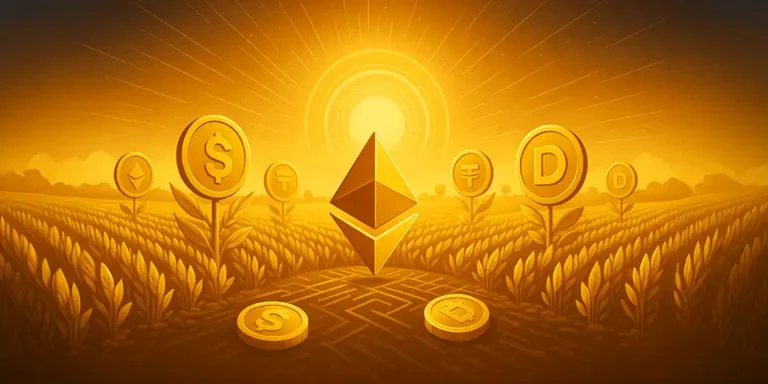Suppose you’re a digital farmer, tossing crypto seeds into a blockchain-powered field and waking up to a harvest of tokens. Sounds wild, right? That’s yield farming for you, a harrowing ride where risks and rewards collide in the DeFi universe. Yield farming is still buzzing, but it’s grown sharper, smarter, and a tad less chaotic. Whether you’re a newbie dipping toes in crypto or a pro chasing alpha, let’s unpack yield farming like we’re chatting over coffee.
So, what exactly is yield farming?
Let’s cut the jargon. Yield farming is like renting out your crypto to earn extra cash. You stash your coins in DeFi platforms (think Uniswap V4 or Aave Pro), and they pay you interest, kind of like a high-tech savings account, but with twists. These platforms pool your funds so traders can swap tokens, and you get a cut of the fees. Sometimes, you’ll even snag shiny new governance tokens. APYs? They range from 5% to 300%, but remember: the juicier the reward, the hairier the risks.
Oh, and it’s not free money. Imagine planting tomatoes only to see a frost wipe them out. In contrast to holding it, you will suffer an impermanent loss if the value of your cryptocurrency declines. Plus, hackers love lurking in poorly audited smart contracts. Thankfully, 2025’s tools are slicker: AI dashboards like YieldGenius scream warnings if a pool smells fishy. Still, DYOR (Do Your Own Research) isn’t just slang, it’s survival.
Yield farming vs. fixed deposits: The crypto savings showdown
Think of yield farming in DeFi (Decentralized Finance) as the rebellious cousin of traditional fixed deposits in CeFi (Centralized Finance). Both let you earn interest on parked funds, but that’s where the similarities end. Let’s break it down:
- Risk Level: Fixed deposits are like cozy campfires—low-risk, often insured, and predictable. Yield farming? More like skydiving. Market swings, smart contract bugs, and rug pulls (where devs vanish with your cash) can turn your gains to dust.
- Returns: Fixed deposits offer steady, snooze-worthy returns (think 2-5%). Yield farming? It’s the lottery—APYs can skyrocket, but there’s no guarantee. One day you’re farming 300%; the next, your tokens are worth pocket lint.
- Liquidity: Fixed deposits lock your cash for months. Need to bail early? Prepare for penalties. DeFi is a bit kinder: some pools let you withdraw early (for a fee) or use emergency exit strategies.
- Control: CeFi banks call the shots. In DeFi, you pick the playground—stablecoin pools, NFT-boosted farms, or even eco-friendly green pools.
Yield farming’s wild ride: From chaos to almost cool
Rewind to 2020, DeFi Summer. Everyone lost their minds over Compound’s COMP tokens, and yield farming exploded like a meme stock. By 2021, platforms like SushiSwap turned it into a gold rush—farmers chased food coins like hungry raccoons. Then came the crash. 2022-2023’s DeFi Winter froze out sketchy projects, and regulators started snooping.
But 2025? It’s like yield farming got a PhD. Gas fees? Slashed by Layer 3 solutions. Cross-chain swaps? Smooth as butter between Ethereum, Solana, and Cosmos. The EU’s MiCA rules brought order, and even your grandma could farm safely with PancakeSwap’s SafeFarm mode. Oh, and NFTs aren’t just art—stake a RareMoon NFT, and watch your APY jump 20%. Fancy, huh?
How to farm like a pro without losing your shirt
Ready to play? Let’s break it down, step by cozy step:
- Pick Your Tools: Choose a platform. Newcomers might opt for user-friendly interfaces like PancakeSwap V3 or Aave’s “SafeFarm” mode. Pros explore leveraged yield strategies on dYdX or hedge impermanent loss with Uniswap’s dynamic fee tiers.
- Deposit Assets: Pair tokens in a liquidity pool (e.g., ETH/USDC). In 2025, single-asset staking (no pairing required) is gaining traction, reducing complexity.
- Earn Rewards: Earn trading fees and protocol tokens. Some platforms now offer NFT yield boosts—staking a RareMoon NFT might amplify your APY by 20%!
- Compound or Cash Out: Reinvest rewards for compound growth or swap them for stablecoins during market dips.
The secret sauce: How yield farming really works
When you deposit funds into a pool, you’re essentially providing liquidity for traders. Automated market makers (AMMs) use algorithms to set prices, rewarding you with a slice of every transaction fee. Protocols further incentivize participation by distributing governance tokens, which grant voting rights or future revenue shares.
In 2025, innovations like “time-locked yields” (higher APYs for longer commitments) and “green farming” (eco-friendly pools powered by proof-of-stake chains) are trending. Meanwhile, decentralized insurance protocols like Nexus Mutual safeguard against smart contract failures, a must in today’s landscape.
The takeaway: Farm smart, not hard
Yield farming in 2025 isn’t just for degens; it’s a legit wealth-building tool. But tread carefully. Start small, spread your bets, and never stop learning. The crypto soil’s rich, but only if you plant wisely. So, slap on your digital overalls, friend. Your crypto harvest awaits—just watch out for those weeds!










